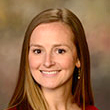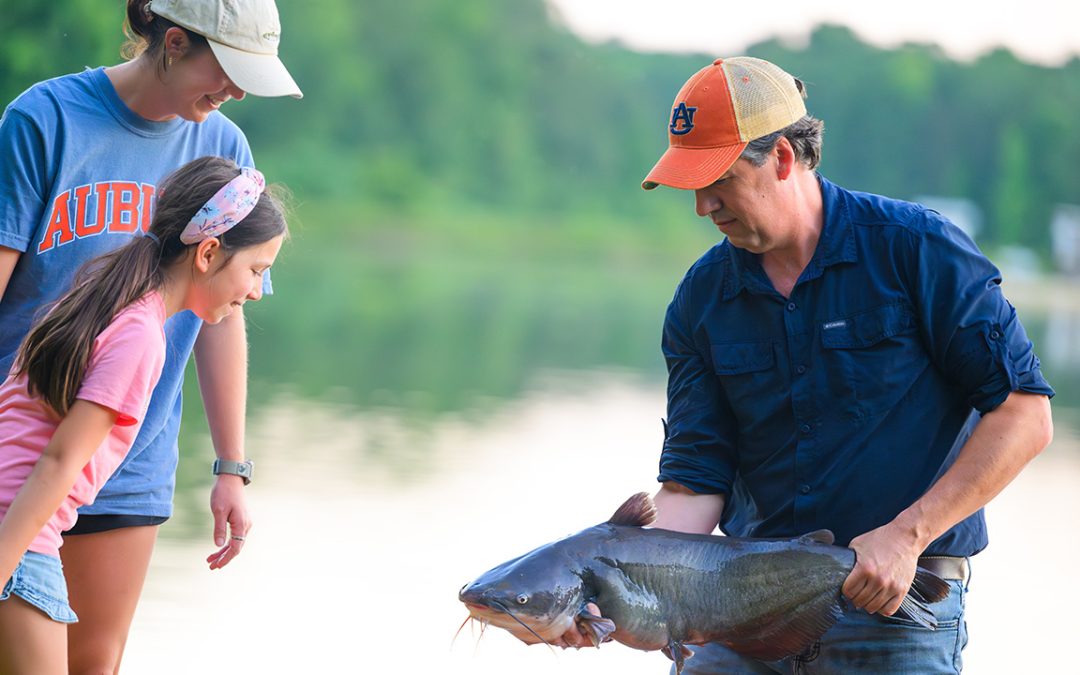Former fisheries faculty practices what he preached raising inland shrimp
by
 About this time every year, David Teichert-Coddington packs his bag, loads his trailer and hits the road, bound for the Florida Keys.
About this time every year, David Teichert-Coddington packs his bag, loads his trailer and hits the road, bound for the Florida Keys.
If he were going for a few weeks of R & R, that would be one thing. But this is business, as will be evidenced four days and 1,850 miles later when a road-weary Teichert-Coddington returns to his west-central Alabama home, hauling a load of precious—and totally legal—cargo: 9 million pathogen-free, hatchery-grown baby shrimp. Shrimplets, if you will, each about the size of a gnat.
And thus begins another growing season at Greene Prairie Shrimp, a fitting name for a farming operation that’s in Greene County on 250 acres of prairie soil and for which the sole product is Pacific white shrimp.
In a county that’s a good 150 miles from the Gulf Coast, saltwater shrimp may seem an unlikely agricultural product. But after a couple of early years of costly production trials and errors and of marketing woes that were on par with the production troubles, Greene Prairie Shrimp manager/owner Teichert-Coddington and co-owner Rudy Schmittou—both alumni of and former faculty in Auburn University’s School of Fisheries, Aquaculture and Aquatic Science—appear to have made it work.
“We currently have paid off most of our debts and are contributing quite heavily to Uncle Sam,” Teichert-Coddington says.
Since establishing the farm in 2001 on newly purchased land that historically had been pasture, the two have grown the operation in the tiny town of Boligee from its initial 10 ponds encompassing 30 acres and a mere 20 percent survival rate to its current 22 ponds totaling 72 acres of water and an annual fall harvest of 300,000 pounds of sweet, delicately flavored shrimp.
And as opposed to that first year, when Teichert-Coddington basically went door to door peddling the piddling crop, the bulk of the farm’s individually flash-frozen shrimp today is shipped to Greene Prairie’s two major clients: Albion Fisheries Ltd. in Vancouver, Canada, a company that supplies sustainably produced seafood to high-end restaurants and retailers throughout British Columbia, and Whole Foods Market Inc., a conglomerate that has made its fortune selling all-natural seafood and other products produced by trusted farmer partners who are committed to the healthiest, most environmentally friendly practices possible.
Go down the lists of strict quality standards both corporations maintain, and Greene Prairie shrimp meet or surpass all.
“Our shrimp are an all-natural, superior-quality, disease-free product grown without chemicals, antibiotics or hormones in ponds filled with brackish water that’s pumped from a low-salinity underground aquifer,” says Schmittou, an Auburn resident and fisheries professor emeritus internationally known for advancing aquaculture in Alabama and overseas during his lengthy career. “We don’t add preservatives or water-enhancing salts during processing, either. We’re as close to organic as you can get.”
And that was their goal from the get-go, Teichert-Coddington says.
“Our promise was to raise and market shrimp that were chemical free from start to finish,” he says, “and that is finally paying off.”
The question of whether it would be possible to keep that promise, or to farm inland shrimp at all, was but one of many uncertainties the two men faced from the day in 1999 when Teichert-Coddington, then an assistant professor of fisheries at Auburn and the state aquaculture specialist for the Alabama Cooperative Extension System, spotted a For Sale sign posted on the property that’s now home to Greene Prairie Shrimp. We’re talking a high-risk venture.
But Teichert-Coddington is nothing if not adventuresome. Whether that’s genetic or a product of his childhood environment is a toss-up.
He was raised in a cement-block house that sat about the length of a football field away from the Atlantic Ocean’s high-tide mark on the coast of West Africa, a dozen miles south of Monrovia. In the 13 years the Liberian-born son of American missionaries called that part of the world home, he developed a passion for the outdoors and water.
“I grew up with the constant sound of pounding ocean, onshore breezes, 95 percent humidity and sand everywhere, including my bed,” the Liberian-born son of American missionaries says. “When I wasn’t going to the mission school, I was on the beach, riding the waves, skin diving or climbing around the ancient basaltic rocks.”
The Coddington family returned to the States, where he finished high school and in 1976 earned a biology degree from a Wesleyan Methodist–affiliated college in New York State. But jobs for biology majors were scarce, so, somehow, he wound up working construction in Kansas with an agency called the Mennonite Voluntary Service. That, incidentally, is where he met Nadine Teichert, a registered nurse out of Georgetown University, and, after a couple of years of fervent wooing on his part, the two were married and became the Teichert-Coddingtons.
As a married man, he decided it was time to get serious with his life.
“I knew I wanted to return overseas someday to do some form of nutritional enhancement for disadvantaged people,” he says. “I also wanted to return to my water roots and work with fish.”
Marine biology seemed a logical choice, but in his search for a solid graduate program in that field, he discovered a concept known as aquaculture and a Deep South school called Auburn University that not only had a graduate program in aquaculture and fisheries but also was home to an International Center for Aquaculture. Perfect. Auburn it was.
He completed his master’s in 1982 and was working on his Ph.D. with a focus on water quality when an opportunity to go to Panama as part of an Auburn fisheries research and development project arose. So in 1985, he, his wife and toddlers Jonathan and Luke settled in Central America for what would be a decade, the first three years in Panama and the last seven in Honduras.
The family returned to Auburn in 1995 so that Jonathan and Luke, who by then were teens, could attend schools in their native country and become as fluent in English as they were in Spanish, and so that Joel, a Honduran who had become part of the family at 2 months of age, could be immersed in his new world.
Through his years with Auburn fisheries, Teichert-Coddington had held various titles, but none that would allow him to advance within the university’s tenure-track system. That finally changed in ’98 when he was hired to his Extension/assistant professor position.
The day he saw the land for sale, he was in west Alabama visiting area catfish farms, including those of Dickie Odom and Rafe Taylor, two growers he had helped establish experimental trials to study the feasibility of growing shrimp in ponds with a salinity level that’s a mere 10 percent that of seawater. That experience, and his increased interaction with farmers overall via his Extension role had been weighing on his mind.
“Every time I worked with farmers, I felt at a disadvantage because I had never actually had to make a living farming,” he says. “I had never been in their shoes.”
Since returning to Auburn in 1995, Teichert-Coddington had traveled to China several times with Schmittou to work on an American Soybean Association projects Schmittou had been hired as a consultant on, and they’d spent a lot of time discussing their philosophies on aquaculture.
“We discovered we shared a common vision on how aquaculture should be done and also on the power of demonstrations for educating farmers,” Teichert-Coddington says. “Plus, I had often thought about farming, and Rud grew up on a farm and had a desire to do so again.”
Which is why Teichert-Coddington did what he did when he happened upon the land offering off U.S. Highway 43 between Eutaw and Demopolis.
“I called Rud and just flat out asked him if he was interested, and he was,” Teichert-Coddington says. “Very.”
And with that, the two entered the world of finance, business plans and everything else involved in buying property and establishing a business. In 2000, Teichert-Coddington gave up the security that his fisheries faculty position provided and, with Schmittou, took a major gamble, officially purchasing the Greene County acreage, without even knowing for absolute certain that the salty aquifer did indeed run underneath their land.
Both now admit those times put their nerves of steel to the test.
“All of this, every bit of it, was done with the absolute terror that we quickly could
lose the property and a bunch of investment money neither one of us could really afford to lose if we didn’t make it produce profitably,” Teichert-Coddington says.“And I guess the biggest thing was, we knew, too, that we could lose prestige,
in that we were university men, professors, trying to succeed in something we had lectured about for years.”
But, so far, anyway, the two have demonstrated that they do practice what they preached.
For more about the farm, visit http://www.greeneprairieshrimp.com/.




